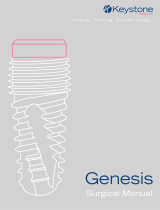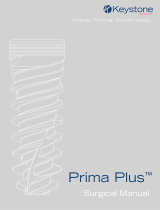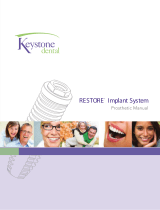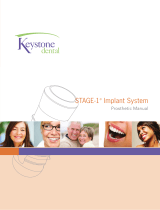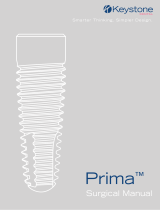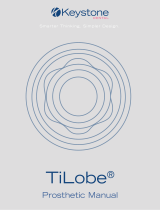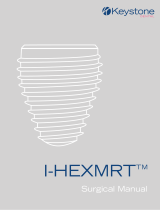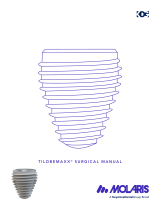Page is loading ...

Torq control ®
US - INSTRUCTIONS FOR USE
US - TORQUE WRENCH

14
TABLE OF CONTENTS
I. DESCRIPTION OF SYMBOLS USED
II. AREA OF APPLICATION
III. GENERAL SAFETY INFORMATION
IV. TECHNICAL CHARACTERISTICS
V. USING THE TORQUE WRENCH
VI. HYGIENE AND MAINTENANCE
VII. CALIBRATION
VIII. REPAIR
IX. GUARANTEES
X. MEDICAL DEVICE REFERENCES
XI. DISPOSAL OF THE PRODUCT
I. DESCRIPTION OF SYMBOLS USED
DANGER SYMBOLS REMARKS
EWARNING:
Important Informaon! U
General indicaons with
no danger to people or
objects
rWear gloves DPlease read this!
xVisual Examinaon
II. AREA OF APPLICATION
The torque wrench is used for dental requirements in the area of
dental surgery (enamel and denne treatment, cung crowns.
etc); any other form of use is forbidden and can cause danger.
This is an instrument with a precise system of torque control
allowing the screwing of prosthec parts at a denite torque.
For this torque wrench, we applied Community Direcve 93/42/
EEC, transposed by the French regulaons on medical equipment
(Ocial Bullen - L169 - 12 July 1993).
DIn accordance with these provisions, the torque wrench
must only be used by someone with experience of dental
medicine, and specially knowledge in implantology as well as in
prosthec technique related to dental implant for the applicaon
described here above, and in compliance with the provisions in
eect in relaon to the prevenon of accidents at work,
protecon of employment and the instrucons for use.
In accordance with these provisions, the user must:
- only use working instruments without defects,
- observe the principle of correct use,
- protect themselves and the paent or third party against any
danger,
- prevent all contaminaon by the product.
III. GENERAL SAFETY INFORMATION
E
Before use, check that the torque wrench is not damaged
or that no part of it is missing. Use protecve gloves,
glasses and a mask.
Aer inseron of a rotary instrument, check that it is correctly
held, by a slight rotary movement.
Do not handle the rotary instrument during operaon.
If you press the push buon during the operaon of the
instrument, the rotary instrument can get out of its posion. It

15
Français
English (UK)
Deutsch Español Italiano Português
Nederlands English (US)
SvenskaNorskDansk
Suomi
中国
يب
� رع
is recommended to the praconer to test the torque wrench
before using it on the paent in order to check the good
funconing.
E
In the event of visible malfuncon or damage, immediately
stop using the instrument and inform your approved
distributor or the manufacturer.
UIn the event of any quesons on the equipment, contact
either your approved distributor or the manufacturer.
IV. TECHNICAL CHARACTERISTICS
Weight (g) 130
Input power Manual
Tool type according to NF EN ISO 1797-1 Type 1
Diameter of tools (mm) according to NF EN ISO 1797-1 2.35
Head height (mm) 12
Head angulaon (°) 100
Maximum total length of the tool (mm)* 34
Precision (N.cm) +/- 1.5
* Approximate values: In the event of the use of rotaonal instruments which are longer in
diameter, the user is responsible for the appropriate choice of operang condions which
will prevent any risk to the paent or to another person.
Table of the torque value according to Anthogyr prosthec
parts*
In general:
10 15 20 25 30 32 35
M2 covering screw ü
M2 healing screw üüü
M2 prosthec screw
(gold, tanium) üüü
M2 gingival abutment
(gold, tanium) üüüü
M1,4 prosthec screw on
abutment (gold, tanium) ü ü
M1,6 prosthec screw (tanium) ü ü
All the values are indicave. In choosing the torque, follow the recommendaons of the
implant manufacturers.
V. USING THE TORQUE WRENCH
The torque wrench is supplied unlubricated and unsterilized.
Before rst using it, the torque wrench must be lubricated and
sterilized. (See “Hygiene and maintenance” §.)
x
Before use, check that the torque wrench is not damaged
and no part of it is missing.

16
5.1. Connecng / disconnecng the rotary instrument
rThe use of protecve gloves is recommended each me
the tools are handled. Check the condion of the rotary
instruments to be used, and handle them properly and carefully.
Inspect the push buon regularly to ensure that it is properly
xed.
Inserng and ghtening the rotary
instrument
- Apply pressure with the thumb to the
center of the push buon.
- Put the instrument into posion by
turning it slightly in both direcons, unl
it engages, then release the push buon.
- Check that the rotary instrument is
properly aached, through a slight axial
movement on each tool change.
Removal of the rotary instrument
- Apply pressure with the thumb to the center of the push
buon.
- At the same me, remove the rotary instrument.
5.2. Torque selecon
- Turn the selector A in the direcon of the
arrow while maintaining the B ring xed.
- The torque values are indicated on the
instrument.
- The implant manufacturer’s recom-
mendaons are to be followed when
choosing the torque.
5.3. How to screw and reach the torque
Screwing/ Unscrewing
- Maintain the torque wrench in one hand.
- Turn the cylindrical component B unl
an audible click is heard, indicang that
declutching has taken place and that the
selected torque has been aained.
Medical device lifecycle
If used in a proper manner, all medical device parts have a two-
year lifecycle (corresponding to 250 sterilizaon cycles).
However, these indicaons are not a warranty because wear may
appear prematurely, depending on how the device is maintained
(cleaning and sterilizaon).
VI. HYGIENE AND MAINTENANCE
The re-sterilizaon of reusable medical devices must be
performed by a properly trained and protected member of sta,
in accordance with the regulaons currently in force.
The re-sterilizaon protocol must take into account the risk of
infecon.
Refer to the manufacturer’s instrucons for each product used.
Take parcular care to adhere to the instrucons regarding
concentraons, lengths of exposure, the replacement of
soluons, and the lifespan of the products. Never combine
products. Adhere to the guidelines regarding the disposal of
used products.

17
Français
English (UK)
Deutsch Español Italiano Português
Nederlands English (US)
SvenskaNorskDansk
Suomi
中国
يب
� رع
5.1. Connecng / disconnecng the rotary instrument
rThe use of protecve gloves is recommended each me
the tools are handled. Check the condion of the rotary
instruments to be used, and handle them properly and carefully.
Inspect the push buon regularly to ensure that it is properly
xed.
Inserng and ghtening the rotary
instrument
- Apply pressure with the thumb to the
center of the push buon.
- Put the instrument into posion by
turning it slightly in both direcons, unl
it engages, then release the push buon.
- Check that the rotary instrument is
properly aached, through a slight axial
movement on each tool change.
Removal of the rotary instrument
- Apply pressure with the thumb to the center of the push
buon.
- At the same me, remove the rotary instrument.
5.2. Torque selecon
- Turn the selector A in the direcon of the
arrow while maintaining the B ring xed.
- The torque values are indicated on the
instrument.
- The implant manufacturer’s recom-
mendaons are to be followed when
choosing the torque.
5.3. How to screw and reach the torque
Screwing/ Unscrewing
- Maintain the torque wrench in one hand.
- Turn the cylindrical component B unl
an audible click is heard, indicang that
declutching has taken place and that the
selected torque has been aained.
Medical device lifecycle
If used in a proper manner, all medical device parts have a two-
year lifecycle (corresponding to 250 sterilizaon cycles).
However, these indicaons are not a warranty because wear may
appear prematurely, depending on how the device is maintained
(cleaning and sterilizaon).
VI. HYGIENE AND MAINTENANCE
The re-sterilizaon of reusable medical devices must be
performed by a properly trained and protected member of sta,
in accordance with the regulaons currently in force.
The re-sterilizaon protocol must take into account the risk of
infecon.
Refer to the manufacturer’s instrucons for each product used.
Take parcular care to adhere to the instrucons regarding
concentraons, lengths of exposure, the replacement of
soluons, and the lifespan of the products. Never combine
products. Adhere to the guidelines regarding the disposal of
used products.
rWear suitable protecve clothing.
In order to avoid any risk of infecon and injury, it is vital to
wear protecve gloves.
E
Never immerse the torque wrench in any kind of soluon.
Never clean the torque wrench in an ultrasonic tank.
6.1. Cleaning
The device must be cleaned immediatly aer the operaon.
Use only detergent or disinfectant soluons with a neutral or
slightly alkaline pH. It is extremely unadvisable to use products
which may x proteins to the unit (eg.alcohol, aldehydes...).
EDo not use sodium hypochlorite (bleach): there is a high
risk of corrosion.
External cleaning
The torque wrench can be cleaned by using a brush under tap
water. External disinfecon can be done using a spray or a wipe
soaked with microbicidal disinfectant products (pH between
2.5-9).
In any case, it is important to follow the reacon me of the
disinfectant product used.
EDo not use disinfectant containing alkaline and chlorine.
Do not immerse the torque wrench in a disinfectant
soluon or in an ultrasound container.
6.2. Lubricaon
This should be done before using for the rst me, and before
each sterilizaon.
EKeep away from any source of heat or ignion.
In parcular, do not smoke!
Wear a protecve face mask.
- Place a turbine-type nozzle (P/N 1933X) on the spray can.
- Place the spray can nozzle into the opening located on the
backside of the torque wrench.
- Maintain the spray can nozzle against the torque wrench unl
the pressure drops again. Vaporize 1 to 2 seconds. The oil
passes over the enre instrument, acng as a cleanser and a
lubricant. Prior to each sterilizaon, lubricaon is to be carried
out using a spray can.
Spray Apply pressure to obtain ghtness
6.3. Sterilizaon
EgWe strongly recommend the use of a class B sterilizer.
Any other method of sterilizaon should be avoided.
DRead the instrucon leaet provided by the sterilizer
manufacturer. Adhere to the space specied between pouches
and do not overload the sterilizer.

18
- Only sterilize instruments which have previously been
disinfected, cleaned, lubricated and tested.
- Remove the rotary instrument from the torque wrench prior
to sterilizaon. (See §5.1.)
- Make sure that the device does not have any areas of corrosion
or cracks, and check that it is operang properly. Ensure that
the product is dry; if necessary, dry any residual water with
medical quality pressurized air.
- Use sterilizaon pouches suitable for the torque wrench and
the sterilizer. Always use one single torque wrench per pouch.
- In order to prevent any retenon of water, place the pouch
in the sterilizer in such a way that any concave parts are face
down.
- If the sterilizer has several types of cycle, choose a cycle
designed for medical devices (a minimum of 135°C at 2.13
bars (275°F at 30.88 psi) for 18 minutes).
- Aer each sterilizaon cycle, check that there is no water
remaining on the inside and outside of the packaging. Make
sure that the ow indicator has changed to the correct color.
- Keep the devices in the sterilizaon pouches away from
light, moisture and any kind of contaminaon. Follow the
manufacturer’s recommendaons as seen on the packaging.
- The duraon for which the device is kept aer sterilizaon
should not exceed 1 month. Label the devices, specifying the
expiraon date. Aer the expiraon date, repeat the cleaning
and sterilizaon procedure.
VII. CALIBRATION
In order to maintain the precision of the torque values, it
is recommended that the torque wrench be returned for
calibraon every 2,000 uses or every 2 years.
VIII. REPAIR
In the event of breakage, please contact your approved
distributor or the Anthogyr aer sales service department
directly.
E
All repairs must be carried out with parts and subassemblies
approved by the manufacturer.
Repairs must only be carried out by an approved distributor or
by the aer sales service department in the factory.
For service or repair, the equipment must be returned complete
and sterile to the aer sales service department. The equipment
must be sent together with a document stang the problem as
well as the complete name and address of the denst.
For any claims to be considered under the guarantee, please
enclose a copy of the invoice or the delivery note with the
equipment.
For every service or repair, send the complete torque wrench.
Replacement parts are available for 7 years beyond sales
disconnuaon of the model.

19
Français
English (UK)
Deutsch Español Italiano Português
Nederlands English (US)
SvenskaNorskDansk
Suomi
中国
يب
� رع
IX. GUARANTEES
This MD is guaranteed parts and labour against all manufacturing
defects for 12 months from the date of invoice.
This guarantee does not apply to wear and tear parts.
All changes or addions to the product without the express
agreement of Anthogyr render this guarantee null and void.
The guarantee becomes null and void if the technical instrucons
are not followed.
Anthogyr cannot be held responsible for damage resulng
from or which could result from normal wear, use, cleaning or
incorrect maintenance, the non-observance of instrucons for
use or connecon, scaling or corrosion, impuries in the water
supply system or unusual chemical or electrical inuences or
non observance of the instrucons, maintenance instrucons
and assembly of Anthogyr and other manufacturer’s instrucons.
Delivery charges incurred when sending an instrument back to
Anthogyr for repair will be paid by the client, even if the repair
itself is covered by the guarantee.
Postage and packing fees when returning the instrument to the
client are covered by the guarantee.
So that guarantee requests are taken into consideraon, please
aach a copy of the invoice or a copy of the delivery slip to
the MD.
X. MEDICAL DEVICE REFERENCES
Descripon References
DYNAMOMETRIC C.A TORQCONTROL 15501
DYNAMOMETRIC C.A TORQCONTROL 15501-P
DYNAMOMETRIC C.A TORQCONTROL 15501S
XI. DISPOSAL OF THE PRODUCT
As far as is currently known, the product does not contain any
substances which are harmful to the environment. The product
must be sterilized before being disposed of. Observe naonal
rules with regard to disposal.

A Anthogyr
2237 avenue André Lasquin
74700 SALLANCHES - FRANCE
Tel. +33 (0) 4 50 58 02 37
Fax +33 (0)4 50 93 78 60
N°SAV / Repairs: 33 (0)4 50 58 50 53
E-mail: contact@anthogyr.com
www.anthogyr.com
K
16315500_NOT_B Validity date : 2021-03 Made in France
/








